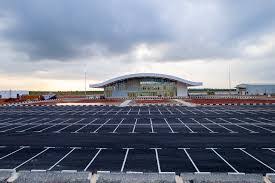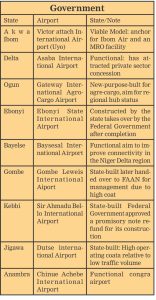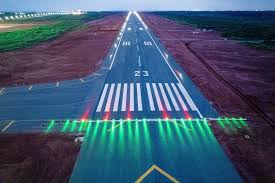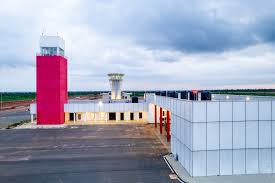- Ogun Airport, fastest built aerodrome in Nigeria, as commercial flight services begin
- Ogun Airport: Paradigm shift, stark dichotomy from the past
- Terminally ill retired AVM dies onboard BA
- IATA age limit rejection by ICAO sparks pilots’ mixed reactions
- Kuku justifies N712bn Lagos airport rebuild project, says Terminal I obsolete
Ogun Airport: Paradigm shift, stark dichotomy from the past

Airports are visible, “shiny” symbols of development and modernity. For governors, completing an airport allows them to boast about “connecting” their state to the rest of the country and the world, serving as a powerful legacy project, writes WOLE SHADARE
When the Ogun State Government, little over five years came up with the idea of building the Gateway International Agro-Cargo Airport, many did not give it a chance that the projection would come to fruition.
No one should be blamed for not having faith in the project, especially going by the controversy that led to a feud between the immediate past governor of Ogun State, Senator Ibikunle Amosun and his successor, Prince Dapo Abiodun, over the location of the new facility.

Rancour gave rise to reason as Governor Abiodun had his way in what appears to be his legacy project for the state.
Approval
After getting the certification needed by the state from the Nigeria Civil Aviation Authority (NCAA), the airport will today be opened to commercial activities as ValueJet became the first airline in Nigeria to begin air services from the airport to Abuja.
The air is thick with the scent of opportunity in Ilishan-Remo, Ogun State, where the towering control structure of the new airport signals a paradigm shift for Nigeria’s economic landscape.
More than just a tarmac and a terminal, this massive infrastructure project is the latest and most explicit representation of a powerful, nationwide concept: that modern airports are no longer just travel facilities—they are indispensable engines of economic development.
Strategy
The Gateway Airport, strategically located near the Sagamu Interchange along the bustling Lagos-Ibadan Expressway, is a clear example of how strategic aviation infrastructure is being leveraged as a powerful fiscal tool.
Its defining feature is its 4-kilometre runway—one of the longest and widest in West Africa—designed to accommodate wide-body and ultra-long-haul aircraft, including a Boeing 777 and even an Airbus A380.
The core of the Ogun Airport’s economic proposition lies in its specialisation. Conceived primarily as an Agro-Cargo hub, its mission is to revolutionise Nigeria’s agricultural value chain.
For years, post-harvest losses and complex logistics have been a major bottleneck for farmers. With a dedicated cargo airport, the swift export of perishable goods—from fresh fruits and vegetables to flowers—will become a reality.
This airport has a transformative effect on the agricultural sector,” explains an expert on the project’s vision.
“By providing a dedicated facility for swift export, farmers can get their produce to international markets quickly, reducing waste and significantly increasing profitability and foreign exchange earnings.
The project extends far beyond the runway. It is the anchor for a sprawling “Aerotropolis”—a self-sustaining airport city spanning over 5,000 hectares. This master plan includes a Special Agro-Processing Zone (SAPZ) where companies will process and package agricultural products for export, adding value and creating an integrated logistics and industrial ecosystem.

Successful model
This model of airport-centric development is projected to generate over 25,000 direct and indirect jobs in sectors spanning aviation, logistics, agro-processing, and hospitality.
The most significant and far-reaching impact—an airport’s ability to facilitate trade, tourism, and attract foreign direct investment.
In Nigeria, the air transport sector as a whole is a major contributor to the economy, supporting hundreds of thousands of jobs and billions in GDP.
The country’s existing hubs, like the Murtala Muhammed International Airport (MMIA) in Lagos, have historically been crucial to trade and commerce.
However, the new generation of state-level airports, like Ogun, and the strategic upgrades of facilities like the one in Ibadan, offer critical solutions such as decongestion.
Gateway Airport is poised to serve as an alternative to the heavily congested Lagos airport, offering a more efficient entry and exit point for passengers and, crucially, cargo from the South-West region.
Expert’s view
The Special Adviser to the Ogun State Governor, Kayode Akinmade, said, “The success of the Ogun Airport’s Aerotropolis concept—merging aviation with industrial parks, residential estates, and business districts—is a litmus test for future airport projects in Nigeria.”
“By building state-of-the-art facilities with a clear focus on commercial value chains like agro-allied export, these new hubs are not merely prestige projects. They are calculated, long-term investments designed to diversify state revenues, create mass employment, and structurally position Nigeria’s regions for global trade competitiveness.”
The Ogun State adventure in airport project is among a growing number of airports in Nigeria that are state-owned, with states like Akwa Ibom, Delta, Ebonyi, Jigawa, Kebbi and Bayelsa investing massive public funds into their construction.

However, the economic impact of these airports is sharply divided between a few successful models and a larger majority that are deemed unviable financial liabilities.
While the Federal Airports Authority of Nigeria (FAAN) operates the majority of commercial airports (26 of 32), many recent or notable airport projects were initiated and funded by state governments.
Economic Impact and Viability
The economic impact of state-owned airports in Nigeria presents a stark dichotomy: a handful of successful projects versus a majority that drains public funds. The most common criticism of state-owned airports is that they are unviable vanity projects that divert scarce resources from essential social services.
Only three to four of Nigeria’s over 30 airports (Lagos, Abuja, and sometimes Kano and Port Harcourt) are financially profitable. The remaining airports, including many state-built ones, operate at a loss.
For example, some state-built airports that have been transferred to FAAN (like in Bauchi, Kebbi, Dutse, and Gombe) become a drain on FAAN’s resources, forcing the profitable hubs to cross-subsidise their operations.
Low Traffic
Many of these airports record abysmally low passenger and cargo traffic, sometimes hosting just a few flights per week, which is insufficient to cover the high fixed operational and maintenance costs. The total passenger traffic across Nigeria is heavily concentrated, with only three airports handling over 92% of all passenger journeys.
The Success Model
Conversely, some state investments demonstrate how airports can be powerful economic drivers when tied to clear business models and professional management.

The Victor Attah International Airport, Akwa Ibom, is often cited as the most successful state-led aviation ecosystem in Nigeria.
The airport is home to a major MRO facility, which aims to capture a share of the millions of dollars African airlines currently spend on aircraft maintenance abroad, positioning the state as a regional aviation hub.
The Ogun Airport is betting on a specific agro-cargo niche to drive its economic viability. The strategic goal is to leverage the airport to streamline the export of perishable goods (agro-produce) and finished industrial products, reducing post-harvest losses and boosting non-oil foreign exchange earnings.
The airport is planned as an anchor for a massive Aerotropolis (airport city), including a Special Agro-Processing Zone (SAPZ) to attract industries, create a logistics hub, and generate tens of thousands of jobs.
Conclusion
 Gateway International Airport
Gateway International Airport
While the rhetoric is focused on economic transformation, the reality of many state-owned airports is a high cost of maintenance against very low passenger traffic, leading to questions about whether the true motives are more political than developmental.
Google+


Artistic photography often focuses on revealing the harmony of the body lines.
It is about light rather than exposure.
Experienced photographers use subtle contrasts to reflect atmosphere.
Such images emphasize artistry and individuality.
https://xnudes.ai/
Every frame aims to show emotion through form.
The purpose is to portray natural harmony in an elegant way.
Audiences often value such work for its creativity.
This style of photography unites technique and vision into something truly timeless.
Artistic photography often focuses on highlighting the harmony of the human form.
It is about composition rather than exposure.
Professional photographers use soft lighting to reflect emotion.
Such images capture delicacy and character.
https://xnudes.ai/
Every frame aims to show emotion through pose.
The intention is to portray inner grace in an respectful way.
Observers often value such work for its depth.
This style of photography unites emotion and aesthetics into something truly timeless.